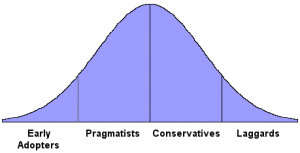
Do you find that some clients are open to change, they embrace change while others see change as disruptive and possibly threatening? And then you find there are those clients who don’t see they need to change at all, they seem ambivalent or oblivious to the need to change.
Whoever is in charge of the buying decisions in an organisation (or family, or partnership) can severely affect, for good or bad, the perception of change across the whole culture. For instance, you may introduce to your clients a new way of doing something that offers increased efficiencies, improved effectiveness, and lowers risk dramatically in their business. To you this is a no-brainer. You are convinced that everyone will see just how fantastic this is for them so you go to market full of vim and vigour only to find that very few share your enthusiasm for this wonderful solution.
Well, we have to look at how people view change. We’ve all heard the saying ‘people don’t like change’ and that may be true for some but it is not true for everyone.
To be able to help our clients navigate change we need to first gauge their appetite for change.
Here are 4 categories of buyers you are likely to encounter in your sales world:
- Early Adopters: These are buyers who tend to lead organisations. They have plenty of drive and embrace change as a way of improving the current situation and help grow the business. They accept and recognise that change is inevitable and rather than resist they look to be the first with new ideas, concepts and solutions. Early adopters expect salespeople to bring new ideas or concepts. They like to experiment and gain a competitive advantage.
- Pragmatists: These buyers are concerned with results rather than theories or principles. Ideas have to have a proven track record. As salespeople we can help these buyers by showing them how our solutions can create the desired change they seek in practical terms.
- Conservatives: These buyers prefer to maintain the status quo. They know change will happen eventually and in turn will grow to accept the new ideas or solutions. As salespeople we need to chip away as these buyers are not much afraid of change but fearful of the unknown effects of change. We can introduce new ideas or concepts bit by bit so as to reduce the risk of failure. This way, new ideas can be introduced slowly over time. Patience is a virtue is very true here.
- Laggards: These buyers have conducted business the same way for decades and don’t like anything new. Instead of presenting innovative solutions to these buyers we need to package up our ideas or solutions in ways that demonstrate they are proven and tested over time – if we have the choice of using old or new words to describe our products or solutions the best choice would be to use old words so that is fits the boundaries of the these types of buyers.
Remember everybody lives by selling something.
Author: Sue Barrett, www.barrett.com.au



New Article Email Notification